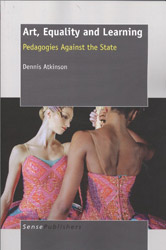Art, Equality and Learning: Pedagogies Against the State
Kim Charnley, Plymouth College of Art
Atkinson, D. (2011), Sense Publishers. .......... This book brings an impressive range of theoretical resources to the task of thinking through the role of the art educator. Atkinson’s work views art education as an arena capable of revealing to learners the true range of their own capacities; yet, this space is always under threat from the ideological forms of closure that are inscribed into ...
 Author: Dennis Atkinson
Author: Dennis AtkinsonPublisher: Sense Publishers
Publication date: 2011
ISBN: 978-94-6091-452-2 (paperback)
Price: £35.00
Art, Equality and Learning: Pedagogies Against the State (henceforth AEL) brings an impressive range of theoretical resources to the task of thinking through the role of the art educator. Atkinson’s work views art education as an arena capable of revealing to learners the true range of their own capacities; yet, this space is always under threat from the ideological forms of closure that are inscribed into forms of curriculum and assessment in art education. As indicated in the uncompromising title, the analysis here is openly politicised. Atkinson diagnoses the contested pedagogic site, in which it is all too easy for teachers to misrecognise the diversity of creative responses in their students, under pressure from ‘systems of regulation’.
Atkinson’s analysis is largely directed at teaching in primary and secondary schools, where stultifying bureaucratic regimes are often joined to a conservative idea of art practice. This does not mean that the work is irrelevant to art education in a Higher Education setting. Many of the concerns of the book can be transposed to all educational levels, and indeed all disciplines. However, Atkinson’s underlying interest in advocating more open methods of teaching practiced by artist-teachers, informed by the diverse practice of contemporary art, is clearly not a central issue for art instruction in Higher Education.
AEL‘s strength is the extended theorised discussion of the arena of art learning, and the responsibility of the art educator working with the inherently open forms of contemporary art. Although Atkinson tends to mix and match theoretical resources –without acknowledging, for example, the well-recorded tensions between the work of Rancière and Badiou – key concepts and their relationship to the practice of teaching are clearly articulated. Although AEL is justly wary of the term ‘ethics’, viewing this as an inherently conservative term, this work can be described as profoundly ethical in the best sense. The concepts, drawn principally from Lacan, Badiou and Rancière, open up teaching and learning to recognition of the ease with which the power vested in the teacher can simultaneously shut them off from learning, whilst imprinting the learner with misrecognition of their own potential. This dynamic remains relevant to HE teaching, especially because of the responsibility involved in deconstructing students’ received ideas about what the practice of art involves. The instruction that is provided through this process must be extremely sensitive to the disturbing potential for teachers to reproduce students in their own image – a fault that is all the more painfully apparent when, in principle, students can do anything.
In AEL Badiou’s understanding of ‘the event’ as a singularity which produces subjectivity is associated with the diverse experiences available in contemporary art. Rancière’s concept ‘dissensus’ is employed to emphasise that consensual teaching experiences are very troubling, in that they suggest a ready acquiescence by students to the authority of the teacher. Following Rancière, Atkinson insists that contemporary art acknowledges the basic equality of student and teacher in any learning experience. Moments of tension, where students resist the direction of teaching, are therefore opportunities – via Lacan’s notion of the other – for all participants in the arena of learning to understand something about the limits of the formation of their self. As Atkinson recognises, this ideal potential of art education is constantly under threat of trivialisation from the bureaucratic forms in which it is embedded. In Higher Education, this includes the lurking question of ‘outcomes’, and the students’ understandable fear about what they will get in return for a lifetime of indebtedness. It is difficult for art education to attain the open-ness described by Atkinson under such circumstances, although it must continue to strive towards it.
Far more common in HE, is the compromise whereby art education falls far short of ‘the event’, and becomes a sophisticated form of commodification of the self. A critical understanding of art is notable for its absence in Atkinson’s account, perhaps because his argument is largely aimed at persuading schools to become aware of contemporary art as having pedagogic significance. Nevertheless, by avoiding the problems of contemporary arts’ institutional and market imbrication, AEL maintains a clear focus on the high stakes involved in art education. Subjectivity is the raw material and the product of this encounter – there is little in the way of a defined body of knowledge to mediate the learning experience. Conceived in this way, art can be learning of the purest kind, but also with the greatest risks. Yet, of course, these risks cannot be avoided, for subjectivity will also be shaped by the forms of our society, one way or another.
Reviewer
Kim Charnley is Contextual Studies Lecturer at Plymouth College of Art.


